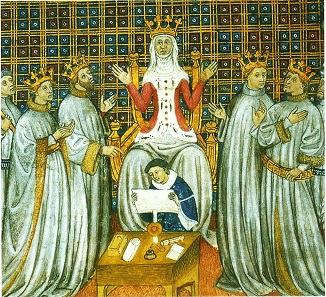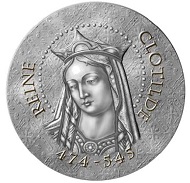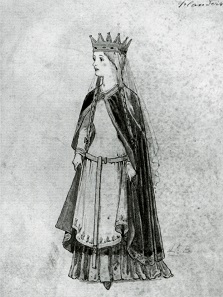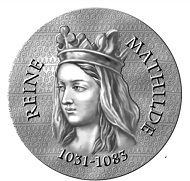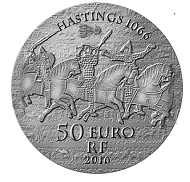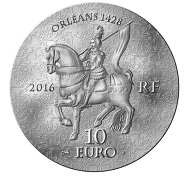June 2, 2016 – In 2016, Monnaie de Paris launches a new series that pays tribute to French History through the women who have had an influence on various areas: politics, art …
This series uses the same historical strike that was used in the ‘From Clovis to the Republic’ series and goes even further: the hammer effect has been replaced by textile patterns representative of the time depicted. This characteristic that brings an additional technical challenge at the time of the strike allows to enrich the drawing of each coin.
This series starts with 3 famous women from middle ages period: Queen Clotilde, Queen Mathilda and Joan of Arc.
Queen Clotilde
Clotilde (c. 474-545), princess of Burgundy, daughter of Chilpéric II and niece of Gondebaud.
He had his two brothers murdered in 491, and took care of his two nieces Clotilde and her sister Chrina.
Queen Clotilde divides her kingdom between the four sons of her late husband Clovis.
Clotilde was a fervent Catholic, was brought up in her mother’s Christian faith.
Clovis, king of the Franks from 481, heard about the youngest descendent of the powerful family of Burgondes. He asked her and to her oncle who accepted. Clovis and Clotilde got married in 493.
Their first two children were baptised at Clotilde’s particular request. It was at the battle of Tolbiac in 496 that Clovis himself promised to convert, on condition that he was victorious. He was subsequently baptised on 25 December 498 in Reims. Highly instrumental in her husband’s conversion to Christianity, Clotilde died around 545 and was canonised around 550.
France / 10 euros / 900 silver / 22.2g / 37mm / Mintage: 5,000.
On the obverse we can find a portrait of Clotilde, presented with an aureola around her head, conforming to her status of Saint. Queen of the Franks, she is wearing a crown. On the background, we can see a drawing treated as a textile pattern. On the reverse, the scene of Clovis’ baptism is depicted. This major event in France’s History has marked Clotilde’s reign. In the background we can find a drawing that enriches the central drawing. Clovis’ baptism date is inscribed on the reverse such as the yeardate.
The coin was launched on 21 March. A 50 euro ¼ oz gold proof coin is also available.
Queen Matilda
Matilda of Flanders (around 1031-1083) is the daughter of the Capetian king Robert II the Pious (996-1031). In 1050 (1051), she married the Duke of Normandy, William the Bastard, who would become William the Conqueror. She became by her wedding, Duchess of Normandy. They built two abbeys in Caen, the Abbaye aux Hommes dedicated to Saint-Etienne founded by Guillaume, and the Abbaye aux Femmes, dedicated to the Holy Trinity, founded by Matilda.
Queen Matilda by an unknown artist.
The Bayeux Tapestry commissioned by Odon de Bayeux (William’s half-brother and bishop of Bayeux from 1049 to 1097), records the events that took place from 1064 to 1066 during the Norman conquest of England. We can see the details of the Hastings Battle. Legend has it that Queen Matilda created the tapestry, assisted by her ladies-in-waiting.
The Hastings Battle took place on the 14th of October 1066 between the last Anglo-Saxon king of England, Harold Godwinson, and the duke of Normandy. Because of his victory, the Duke of Normandy is sacred King of England. The Norman conquest only ended few years later. Matilda was crowned Queen of England in 1068.
France / 10 euros / 900 silver / 22.2g / 37mm / Mintage: 5,000.
The obverse bears a crowned portrait of Matilda. A graphical pattern enhances the central drawing. The reverse shows William the Conqueror at the Battle of Hastings in a famous scene from the Bayeux Tapestry. When the majority of Norman soldiers feared their leader had fallen in battle, William dispelled the rumour by removing his helmet so that his men would recognise him and take courage. On the upper part of the reverse, close to the reference to the Hastings Battle and to its date, the Halley’s comet is depicted, visible in the sky on the day of the Battle.
The coin was launched on 16 May 2016 together with a 200 euro 1 oz gold proof and a 50 euro ¼ oz gold proof version.
Jeanne d’Arc
Joan of Arc was born in Domrémy in the Lorraine region of France around 1412. She claimed, as an adolescent, to have been instructed by saints to free France from English occupation and to conduct the Dauphin on the royal throne. She made it her mission to get to the Dauphin’s side and inform him of her divine calling.
Jeanne d’Arc assisting the coronation of Charles V. Deatil of a painting by Dominique Ingres, 1854.
She announced four events: the liberation of Orléans, the sacre of the king in Reims, the liberation of Paris, and the liberation of the Duke of Orléans.
She became an emblematic figure of the Hundred Years’ War and true military leader. In 1431, after the announced events happened, she was finally captured by the Burgundians, who were allied to the English. Following a trial, she was sentenced to be burnt at the stake.
France / 10 euros / 900 silver / 22.2g / 37mm / Mintage: 5,000.
The obverse bears a portrait of Joan of Arc wearing a helmet. The background is studded with fleur-de-lis. Her banner was white with fleurs-de-lis. Later, Charles VII had her anoblished, she became Lady of lis. The reverse depicts Joan of Arc, mounted and armoured, during the siege of Orléans in 1428. The background features a motif inspired by armour.
The coin will be launched on 11 July 2016 in addition to a 200 euro 1 oz gold proof and a 50 euro ¼ oz gold proof issue.
For more information on the new series go to the Monnaie de Paris website.




